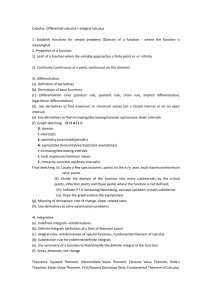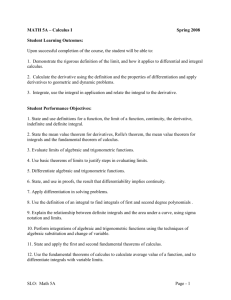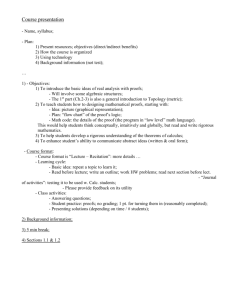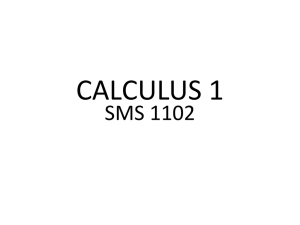Curriculum and Pacing Guide - Mathematics Calculus (1202300)
advertisement
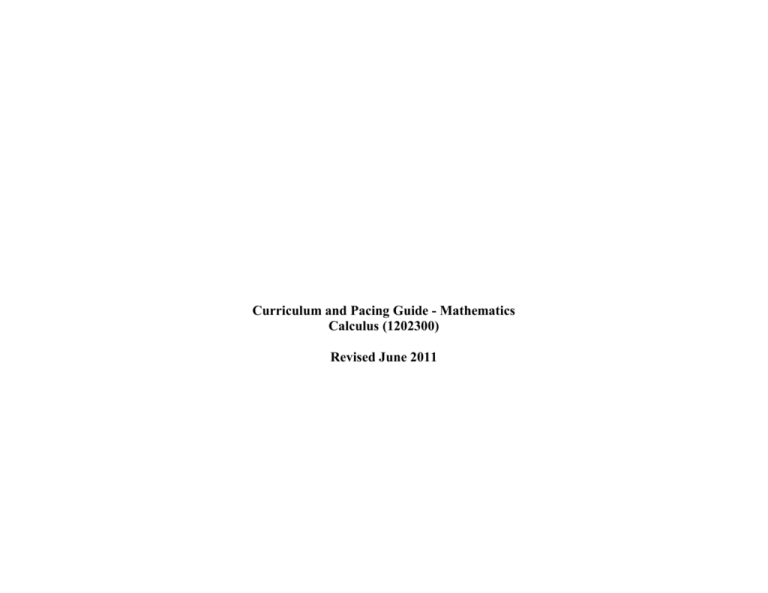
Curriculum and Pacing Guide - Mathematics Calculus (1202300) Revised June 2011 Calculus Honors (1202300) Curriculum and Pacing Guide - Mathematics Calculus Honors (1202300) Revised June 2011 1. Review of the concepts from algebra and pre-calculus concerning relations /functions will probably be necessary to some extent. These include linear, trigonometric, exponential, logarithmic, the generic functions, and piecewise functions. Topics relative to these are; slopes, domain and range, symmetry, intercepts, intersections, and the graphs of these relations/functions. The graphing calculator (TI-89) is used to reinforce these concepts, referring to the solving, table, and graphing capabilities of the calculator. Chapter 1: Prerequisites for Calculus Days Section Topic 2 1.1 Lines 2 1.2 Functions and graphs 2 1.3 Exponential Functions 1 2 1.5 Quiz Functions and Logarithms 3 1.6 Trigonometric Functions 1 1 14 Review Test Total Days Concepts Increments, Slope, Point-slope Form, Slope-intercept, Standard Form (Skip Regression Analysis) Function, Even and Odd Functions, Composition, Piecewise Functions, Recognizing Graphing Failure Exponential Function, Exponential Growth and Decay, Half Life One to One, Logarithms Functions, Inverse Functions, Identity Functions, Change of Base Formula Periodic Function, Period, Trigonometric Functions, Inverse Trig, Even and Odd Suggested Approaches (T) Technology, (V) Verbal, (G) Graphical, (N) Numerical (NV) (TGV) Graphing Features of calculator, Graph Viewing Skills (TG) Graphing and Table Features (VGN) (TVGN) Data Warehouse Questions Calculus Honors (1202300) 2. The concepts of a limit, as the independent variable approaches a particular value, are addressed numerically, analytically, and graphically. This involves developing the ideas of the existence of a limit. The issues are, if the limit exist, what is it, and if it does not, why not? This necessitates the understanding of “broken graph” oscillating, and asymptotic behaviors. Examination of limits, including one sided limits, is done using the various algebra techniques for the types of functions, the properties of limits and special techniques for rational trig related functions. Continuity and the Intermediate Value theorem and their applications are also part of this unit. Areas of application in this unit are finding equations of tangent lines (and normal lines) at a point and beginning motion problems. Chapter 2: Limits and Continuity Days Section Topic Concepts 3 2.1 Rates of Change and Limits Average v. Instantaneous Speed, Properties of Limits, One sided v. Two sided Limits, Sandwich Theorem 3 2.2 Limits Involving Infinity Horizontal Asymptote, Properties of Limits as x approaches infinity, Vertical Asymptote, End Behavior Model 1 3 2.3 3 2.4 1 1 15 Total Days Quiz Continuity Rates of Change and Tangent Lines Review Test Continuity at a Point, Properties of Continuous Functions, Composition of Continuous Functions, Discontinuities, Intermediate Value Theorem, Jump Discontinuity Average Rate of Change, Slope of a Curve at a Point, Tangent Line, Normal to a Curve, Suggested Approaches (T) Technology, (V) Verbal, (G) Graphical, (N) Numerical (T) See www.calculus-help.com (T) table features of calculator (T) trace features of calculator Supplement Algebraic Limit Techniques from Larson (T) See www.calculus-help.com (G) Graphical Data Warehouse Questions 129956 129750,130055,132135,1 32136,134194,134197,13 4202 (T) See www.calculus-help.com (G) Graphical (VN) 129952,134206 (VN) 130125,134233 Calculus Honors (1202300) 3. The derivative is developed in this unit which involves the geometric interpretation of the tangent line at a point, leading to the limit definition of the derivative of a function. The limit definition is used both to find derivatives at a point and to develop the basic derivative rules. Basic derivative rules are used for first, second, and higher order derivatives and also for implicit derivatives. The derivative is also investigated in the relationship between position, velocity, acceleration and jerk. Inverse functions are addressed with particular attention given to the natural exponential function as the inverse of the natural logarithm function. The derivatives of the natural exponential function and the natural log function are given. Logarithmic and exponential functions of any base are also given along with their corresponding derivatives. Various derivative techniques are developed for natural logarithm functions techniques for rational form functions, including trigonometric. Calculus Honors (1202300) Chapter 3: Derivatives Days Section Topic Concepts Derivative, Derivative at a Point, Notation, Relationship between the Graphs of F and F Prime, One-Sided Derivatives Non-Differentiability, Local Linearity Differentiation Rules, Higher Order Derivatives 3 3.1 Derivative of a Function 3 4 3.2 3.3 Differentiability Rules for Differentiation 1 4 3.4 Quiz Velocity and Other Rates of Change 3 3.5 Derivatives of Trigonometric Functions 3 3.6 Chain Rule 1 3 3.7 Mid-Chapter Test Implicit Differentiation 3 3.8 3 3.9 1 1 33 Review Test Total Days Instantaneous Rates of Change, Instantaneous Velocity, Speed, Acceleration, Linear Motion, Free-Fall Motion Derivative of Trig Functions, Jerk, Suggested Approaches (T) Technology, (V) Verbal, (G) Graphical, (N) Numerical (VGN) (T) http://www.ima.umn.ed u/~arnold/graphics.html (VGN) (VN) (T) See www.calculushelp.com Data Warehouse Questions 134218 130126 130054,130068,130 128,130130,134210 ,134215,134217 (VG) 129924,130111,130 127,130132 (VG) Graphical (T) See www.calculushelp.com 130038,130077, 129425,130129,130 131,130322,132149 ,134235 Derivative of Composite Functions, Chain Rule (Skip Slopes of Parameterized Curves) (VN) Implicit Function, Implicit Differentiation, Power Rule for Rational Powers (VN) 129533,130046 Derivatives of Inverse Trigonometric Functions Inverse, Derivatives of Inverse Trigonometric Functions 134016,134050,134 051 Derivatives of Exponential and Logarithmic Functions Derivative of Exponential Functions base e and base a, Derivative of Log Functions base e and base a (VGN) Supplement Theorem 5.9 From Larson for Derivative of Inverse Functions (VN) 129752,134011,134 012 Calculus Honors (1202300) 4. This unit continues the application of derivatives. Also three principle theorems are developed and used – the Extreme Value Theorem, Rolle’s Theorem, and the Mean Value Theorem. First and second derivatives are used to determine for a given function the critical values, intervals of increase and decrease, relative maxima and minima, points of inflection, and intervals concave up and concave down. This application is done with and without graphing calculators. Included with this application is the examination of the relationships of the graphs of a function, the graph of its 1st derivative, and the graph of its 2nd derivative and through the use of tables. The very useful and important derivative application of solving optimization problems, as well as linear approximations, differentials, and related rates are in this unit. Chapter 4: Applications of Derivatives Days Section Topic 5 4.1 Application of Derivatives 3 4.2 Mean Value Theorem 4 4.3 Connecting f prime and f double prime with the graph of f 1 5 3 4.4 4.5 Quiz Modeling and Optimization Linearization 6 4.6 Related Rates 1 1 29 Review Test Total Concepts Absolute Extrema, Local Extreme Values, Critical Point, Extreme Value Theorem, Mean Value Theorem, Increasing Decreasing Intervals, Antiderivative, Rolle’s Theorem, Monotonic Functions First Derivative Test, Definition of Concavity, Concavity Intervals, Point of Inflection, Second Derivative Test, Max-Min Problems, Optimization Linear Approximation, Differentials, Absolute Relative and Percent Change, (Skip Newton’s Method) Related Rates Suggested Approaches (T) Technology, (V) Verbal, (G) Graphical, (N) Numerical (VGN) (VN) (G) (T) www.unitedstreaming.com : “applications of derivatives” (V) (VN) Data Warehouse Questions 129532,130450,1304 56,130457,130458 129761,130053,1303 29,130451,130453,13 4186 129515,130115,1304 60 129760,132143 132151 129753,129947,1301 21 Calculus Honors (1202300) 5. The definite integral is developed by first examining estimates of the areas of plane regions as sums of rectangles constructed by using a partitioning of an interval and the right, left, midpoint or any point of the partition. The definition of a definite integral can then be given as a limit to an infinite Riemann Sum, the exact area of the plane region. The Fundamental Theorem of Calculus is developed along with the Mean Value Theorem for Integrals leading to the Average Value of a function on an interval. The Second Fundamental Theorem is also given. The main applications here are areas of simple plane regions, and average-value-of-a-function problems. This unit also includes estimation of plane regions by using trapezoidal approximation. Chapter 5: The Definite Integral Days Section Topic 3 5.1 Estimating with Finite Sums 4 5.2 Riemann Sums 6 5.3 Definite Integrals and Antiderivatives 1 5 5.4 Quiz Fundamental Theorem of Calculus 3 5.5 Trapezoidal Rule 1 1 24 Review Test Total days Concepts Suggested Approaches (T) Technology, (V) Verbal, (G) Graphical, (N) Numerical (VN) Data Warehouse Questions (VGN) 133934 (VN) 13400,134008 Distance Traveled, 132172,132176 Rectangular Approximation Method Definite Integral, (T, N) Graphing calculator: table 129757,132177,133909,13 Integrability, feature 3912,133915 Integral Properties, Average (VN) 129762,133879,133896,13 Value, Mean Value 3925,133938 Theorem for Integrals Fundamental Theorem of Calculus Part 1 and 2, Connection to Area Trapezoid Rule (Skip Other Algorithms, Simpson’s Rule and Error Bounds) Calculus Honors (1202300) 6. This unit introduces slope fields and the solving of differential equations, leading to the concept of an antiderivative. Indefinite integrals are solved through various techniques including u du substitution and pattern recognition. Exponential growth and decay model is developed from integration of separation of variables. The Logistic Growth model is also included. Chapter 6: Differential Equations and Mathematical Modeling Days Section Topic Concepts 1 6.1 Slope Fields and Euler’s Method 4 6.2 Antidifferentiation by Substitution 4 6.4 Exponential Growth and Decay 1 3 2 1 16 6.5 Quiz Logistic Growth Review Test Total Days Differential Equation, Initial Value (Skip Slope Fields and Euler’s Method) Properties of Indefinite Integrals, Indefinite Integrals, Leibniz Notation, u du substitution Separable Differential Equation, Exponential Change, Continuous and Compound Interest, Modeling Growth and Decay Logistic Differential Equations, Logistic Curve, Logistic Growth Model (Skip Partial Fractions) Suggested Approaches (T) Technology, (V) Verbal, (G) Graphical, (N) Numerical (VN) Data Warehouse Questions (VN) 130071,132164,133919,13 3949,133975,133991,1340 13,134030 (VN) 130082,130326,134034,13 4049,134224,134229 (VN) 129754,134020 Calculus Honors (1202300) 7. This unit involves the interpretation of the integral as an accumulator and applications of finding areas and volumes. The definite Integral is used to find the areas of regions between curves using all types of functions. These are areas on an interval, areas between curves including curves with more than two intersections, also incorporating change of axis. The next application is volume beginning with three diminution shapes also knows as cross sections. Also included are volumes of rotation using the disk, and washer method incorporating the change of axis. Chapter 7: Applications of Definite Integrals Days Section Topic 5 7.1 Integral as Net Change 4 7.2 Areas in the Planes 1 6 7.3 Quiz Volume 2 1 19 Concepts Displacement, Consumption over time, Net Change from Data Area between Curves, Area Enclosed by Intersecting Curves, Integrating in respect to y, Integration by Geometric Formula Cross Sections, Washers (Skip Shells) Suggested Approaches (T) Technology, (V) Verbal, (G) Graphical, (N) Numerical (VN) Data Warehouse Questions (VGN) (T) Calculus in Motion (Fee) 129749,130105,134168 (VGN) (T) Calculus in Motion (Fee) Supplement from Larson for Disk and Washer Methods 129748,130093,134145,134152,134153 Review Test Total Days Total Instructional days: 150 This pacing guide does not count early release days as instructional days. They are to be used as review days, quiz days or for supplemental instruction. Major Text. Taken from: Finney, Damana, Waits and Kennedy. Calculus: Graphical, Numerical, Algebraic (AP Edition), 3rd Ed. Upper Saddle River, New Jersey, 2007 Finney, Damana, Waits and Kennedy. Calculus: A Complete Course, 2nd Ed. Upper Saddle River, New Jersey, 2000

